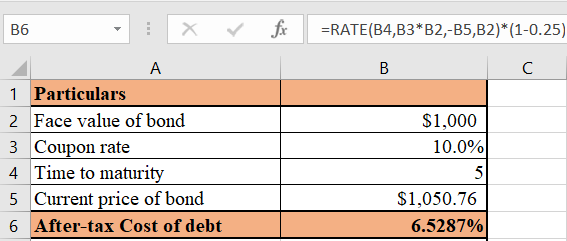Kuhn Co. is considering a new project that will require an initial investment of $45 million. It has a target capital structure of 58% debt, 6% preferred stock, and 36% common equity. Kuhn has noncallable bonds outstanding that mature in five years with a face value of $1,000, an annual coupon rate of 10%, and a market price of $1,050.76. The yield on the company's current bonds is a good approximation of the yield on any new bonds that it issues. The company can sell shares of preferred stock that pay an annual dividend of $9 at a price of $92.25 per share. Kuhn does not have any retained earnings available to finance this project, so the firm will have to issue new common stock to help fund it. Its common stock is currently selling for $22.35 per share, and it is expected to pay a dividend of $2.78 at the end of next year. Flotation costs will represent 3% of the funds raised by issuing new common stock. The company is projected to grow at a constant rate of 8.7%, and they face a tax rate of 25%. What will be the WACC for this project? (Note: Round your intermediate calculations to two decimal places.)
Kuhn Co. is considering a new project that will require an initial investment of $45 million. It has a target capital structure of 58% debt, 6% preferred stock, and 36% common equity. Kuhn has noncallable bonds outstanding that mature in five years with a face value of $1,000, an annual coupon rate of 10%, and a market price of $1,050.76. The yield on the company's current bonds is a good approximation of the yield on any new bonds that it issues. The company can sell shares of preferred stock that pay an annual dividend of $9 at a price of $92.25 per share. Kuhn does not have any retained earnings available to finance this project, so the firm will have to issue new common stock to help fund it. Its common stock is currently selling for $22.35 per share, and it is expected to pay a dividend of $2.78 at the end of next year. Flotation costs will represent 3% of the funds raised by issuing new common stock. The company is projected to grow at a constant rate of 8.7%, and they face a tax rate of 25%. What will be the WACC for this project? (Note: Round your intermediate calculations to two decimal places.)
Essentials Of Investments
11th Edition
ISBN:9781260013924
Author:Bodie, Zvi, Kane, Alex, MARCUS, Alan J.
Publisher:Bodie, Zvi, Kane, Alex, MARCUS, Alan J.
Chapter1: Investments: Background And Issues
Section: Chapter Questions
Problem 1PS
Related questions
Question

Transcribed Image Text:Kuhn Co. is considering a new project that will require an initial investment of $45 million. It has a target capital structure of 58% debt, 6% preferred
stock, and 36% common equity. Kuhn has noncallable bonds outstanding that mature in five years with a face value of $1,000, an annual coupon rate
of 10%, and a market price of $1,050.76. The yield on the company's current bonds is a good approximation of the yield on any new bonds that it
issues. The company can sell shares of preferred stock that pay an annual dividend of $9 at a price of $92.25 per share.
Kuhn does not have any retained earnings available to finance this project, so the firm will have to issue new common stock to help fund it. Its
common stock is currently selling for $22.35 per share, and it is expected to pay a dividend of $2.78 at the end of next year. Flotation costs will
represent 3% of the funds raised by issuing new common stock. The company is projected to grow at a constant rate of 8.7%, and they face a tax
rate of 25%. What will be the WACC for this project?
(Note: Round your intermediate calculations to two decimal places.)
Expert Solution
Step 1
Calculate the after tax cost of debt as follows:

Therefore, after tax cost of debt is 6.53%.
Calculate the cost of preferred stock as follows:
Therefore, the cost of preferred stock is 9.76%.
Calculate the cost of equity as follows:
Therefore, the cost of equity is 21.52%
Trending now
This is a popular solution!
Step by step
Solved in 2 steps with 3 images

Knowledge Booster
Learn more about
Need a deep-dive on the concept behind this application? Look no further. Learn more about this topic, finance and related others by exploring similar questions and additional content below.Recommended textbooks for you

Essentials Of Investments
Finance
ISBN:
9781260013924
Author:
Bodie, Zvi, Kane, Alex, MARCUS, Alan J.
Publisher:
Mcgraw-hill Education,



Essentials Of Investments
Finance
ISBN:
9781260013924
Author:
Bodie, Zvi, Kane, Alex, MARCUS, Alan J.
Publisher:
Mcgraw-hill Education,



Foundations Of Finance
Finance
ISBN:
9780134897264
Author:
KEOWN, Arthur J., Martin, John D., PETTY, J. William
Publisher:
Pearson,

Fundamentals of Financial Management (MindTap Cou…
Finance
ISBN:
9781337395250
Author:
Eugene F. Brigham, Joel F. Houston
Publisher:
Cengage Learning

Corporate Finance (The Mcgraw-hill/Irwin Series i…
Finance
ISBN:
9780077861759
Author:
Stephen A. Ross Franco Modigliani Professor of Financial Economics Professor, Randolph W Westerfield Robert R. Dockson Deans Chair in Bus. Admin., Jeffrey Jaffe, Bradford D Jordan Professor
Publisher:
McGraw-Hill Education